

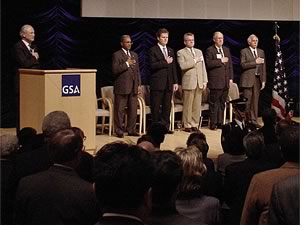 Government
officials and accomplished architects gathered March 27 in the nation’s
capital to honor 24 diverse federal projects as exemplars of design excellence
in public architecture. The winning entries in the U.S. General Services
Administration Design Excellence Awards program ranged from a newly built
border station, to an innovative proposed design for a National Oceanic
and Atmospheric Administration Satellite Operations Facility, to the careful
restoration of a U.S. Post Office and Courthouse in Old San Juan, Puerto
Rico. They spanned the disciplines of new architecture, historic preservation
and renovation, sustainable design, graphic design, and construction excellence.
Overall, agency administrators said, they exemplified GSA’s commitment
to the stewardship of the nation’s public resources and the manifestation
of our nation’s ideals.
Government
officials and accomplished architects gathered March 27 in the nation’s
capital to honor 24 diverse federal projects as exemplars of design excellence
in public architecture. The winning entries in the U.S. General Services
Administration Design Excellence Awards program ranged from a newly built
border station, to an innovative proposed design for a National Oceanic
and Atmospheric Administration Satellite Operations Facility, to the careful
restoration of a U.S. Post Office and Courthouse in Old San Juan, Puerto
Rico. They spanned the disciplines of new architecture, historic preservation
and renovation, sustainable design, graphic design, and construction excellence.
Overall, agency administrators said, they exemplified GSA’s commitment
to the stewardship of the nation’s public resources and the manifestation
of our nation’s ideals.
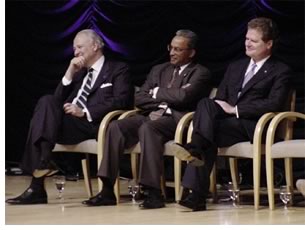 “Through
design, we seek to reinforce democratic values, and to create open, inviting,
civic places,” said F. Joseph Moravec, commissioner of GSA’s
Public Building Service, in his welcoming remarks. AIA President Thompson
E. Penney, FAIA, echoed Moravec’s sentiments. “How powerfully
those words sound today. They speak to us at a time when the architectural
icons of our democracy have seldom been more resonant, yet, at the same
time, so threatened, so in need of our protection and care.”
“Through
design, we seek to reinforce democratic values, and to create open, inviting,
civic places,” said F. Joseph Moravec, commissioner of GSA’s
Public Building Service, in his welcoming remarks. AIA President Thompson
E. Penney, FAIA, echoed Moravec’s sentiments. “How powerfully
those words sound today. They speak to us at a time when the architectural
icons of our democracy have seldom been more resonant, yet, at the same
time, so threatened, so in need of our protection and care.”
“When we present these awards,” Penney continued, “we don’t just celebrate a job well done. Awards are a vehicle for the expression of our values to the public—and to ourselves. The awards we give today illuminate the wide range and profound impact of design on every aspect of our lives, from the dignity of the workplace environment to the urgent need to practice an ethic of sustainability.” Penney joined program participants Moravec; GSA Administrator Stephen Perry; National Trust for Historic Preservation President Richard Moe, Hon. AIA; Design Excellence Jury Chair Moshe Safdie, FAIA; and U.S. District Judge Michael R. Hogan, who worked with Thom Mayne/Morphosis on the award-winning U.S. Courthouse in Eugene, Ore.
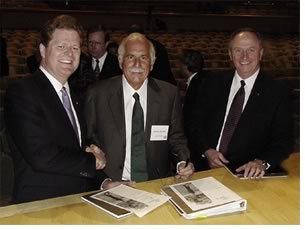 During
the program, the speakers joined in lauding the work of the late U.S.
Sen. Daniel Patrick Moynihan, Hon. AIA, who died March 26. “No member
of Congress has had more of an important effect on the built environment,”
Moe said, reflecting the sentiments of the other participants. Moynihan
was remembered for his dedication to and advocacy of public architecture
and his work 40 years ago as the author of “Guiding Principles for
Federal Architecture,” which officials credit as the basis for the
GSA’s Design Excellence program. “His leadership and insights
were the driving force in so many arenas, most especially his commitment
to making our public buildings a proud symbol and enduring legacy of our
democracy,” Penney said.
During
the program, the speakers joined in lauding the work of the late U.S.
Sen. Daniel Patrick Moynihan, Hon. AIA, who died March 26. “No member
of Congress has had more of an important effect on the built environment,”
Moe said, reflecting the sentiments of the other participants. Moynihan
was remembered for his dedication to and advocacy of public architecture
and his work 40 years ago as the author of “Guiding Principles for
Federal Architecture,” which officials credit as the basis for the
GSA’s Design Excellence program. “His leadership and insights
were the driving force in so many arenas, most especially his commitment
to making our public buildings a proud symbol and enduring legacy of our
democracy,” Penney said.
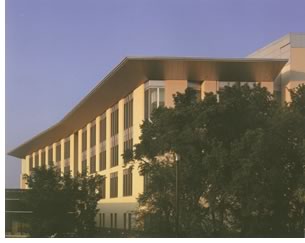 The
award winners
The
award winners
“Overall, we tended to honor buildings that effectively addressed
urban-design challenges and maintained a strong sense of openness. We
also admired projects that were environmentally responsible,” said
Jury Chair Moshe Safdie, FAIA. Joining Safdie on the Design Excellence
jury were Debora Berke, AIA; Richard Brayton, FAIA; Susan Child; Wendy
Feuer; Ethel Kessler; Raymond Messer; Elizabeth Moule; Mary Oehrlein,
FAIA; William Stanley, FAIA; and Joseph Valerio, FAIA.
Following is a complete list of the award-winning projects with the jury’s citations:
 Architecture
Architecture
Harvey W. Wiley Federal Building,
Center for Food Safety and Nutrition, College Park, Md., by N.
Michael McKinnell, Kallmann McKinnell & Wood Architects.
Simple and dignified, yet dynamic, this
building pleasantly infuses natural daylight into offices, labs, and public
spaces alike. (Citation)
Pacific Highway U.S. Port of Entry,
Blaine, Wash., by Thomas Hacker, AIA, Thomas Hacker Architects.
The combination of wood siding and corrugated
metal gives the structure a regional mood and modern legibility.
(Citation)
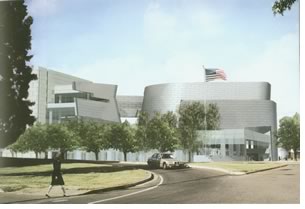 On
the boards
On
the boards
U.S. Courthouse, Eugene,
Ore., by Thom Mayne, AIA, Morphosis. A highly rational plan with fluid,
sculptural massing.
This combination of order and artistry
is an appropriate new symbol for the courts. (Citation)
Census Bureau Headquarters, Suitland,
Md., by Gary Haney, AIA, Skidmore, Owings & Merrill
This project takes landscape design as
seriously as architecture. The workplace maximizes light and views to
create a pleasurable place to spend the day. (Citation)
Temecula Border Patrol Station,
Murietta, Calif., by James Garrison, AIA, Garrison Architects.
The border between the U.S. and Mexico
is made visible in the steel cladding and linear form of this building.
Generous use of glass symbolizes our country’s open society.
(Citation)
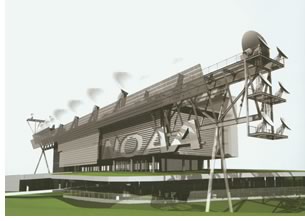 National
Oceanic and Atmospheric Administration Satellite Operations Facility,
Suitland, Md., by Thom Mayne, AIA, Morphosis. Technology
and nature are juxtaposed to create a powerful presence while providing
a good workplace environment within. (Citation)
National
Oceanic and Atmospheric Administration Satellite Operations Facility,
Suitland, Md., by Thom Mayne, AIA, Morphosis. Technology
and nature are juxtaposed to create a powerful presence while providing
a good workplace environment within. (Citation)
Art conservation
“State Pride” and “Justice”
by Leo Friedlander, Nashville, Tenn., by Catherine S. Myers, Art Conservation
Associates.
A team of experts came up with innovative
solutions to the complex problems of rescuing these plaster models.
(Citation)
Engineering/technology
Wallace F. Bennett Federal Building,
Salt Lake City, by A. Parry Brown, Reaveley Engineers & Associates.
Structural upgrading and architectural
cladding preserve a landmark while creating a modern, attractive, and
energy-efficient building. (Honor Award)
Workplace environment
Office of the Chief Architect,
U.S. General Services Administration, Washington, D.C., by Debra Lehman-Smith,
Assoc. AIA, Lehman-Smith McLeish.
Well organized and beautifully detailed,
the space is a handsome home for a federal agency that sponsors world-class
architecture throughout the country. The material palette, while understated,
exudes richness. (Honor Award)
First impressions
James A. Byrne U.S. Courthouse,
Philadelphia, by Alan Greenberger, AIA, MGA Partners
Glass panels combining patriotic imagery
and memorable quotations make the courthouse more welcoming and better
connected to its public purpose. It is easy to imagine a visitor being
inspired by this space. (Citation)
Martinsburg Federal Building and U. S.
Courthouse, Martinsburg, W. Va., by Debra Lehman-Smith, Assoc.
AIA, Lehman-Smith McLeish.
This design shows that a small project
can make a big impact when handled creatively. It supports the GSA’s
efforts to both enhance the workplace and give something back to the larger
community. (Citation)
Graphic design
GSA Design Excellence Monograph
Series, Washington, D.C. by Tom Geismar, Chermayeff & Geismar.
This stunning series exemplifies graphic
design at its best. The format, typography, and photography let the architecture
come to the forefront. Guidelines provide an excellent direction for perpetuating
this series. (Honor Award)
GSA Historic Building Poster Series,
Washington, D.C., by Judith A. Cox, Cox & Associates.
The classical format and scale of these
posters commands attention. High-quality printing and stunning photography
make each design a gem. (Citation)
Jacob Weinberger U. S. Courthouse (San
Diego) Booklet, by Rick Helf, Rightside Imaging.
This charming keepsake successfully tells
the story of the building’s history and preservation. The designer
honors the past with a high-quality piece for the building’s future.
(Citation)
Sandra Day O’Connor U. S. Courthouse
(Phoenix) Tenant Guide, by Ray Vote, Ray Vote Graphics.
Large, complex buildings often need to
be explained to their users. The graphic design of this tenant guide achieves
the same precision and rigor found in the architecture of the courthouse.
(Citation)
Sustainability
U.S. Environmental Protection Agency
Research and Administration Facility, Research Triangle Park, N.C.,
by William K. Hellmuth, FAIA, Hellmuth, Obata + Kassabaum.
Even before the emergence of government-sanctioned
standards for sustainable design, this project incorporated a wide range
of environmentally sensitive features. The campus is a prototype that
has influenced state and national guidelines for “green” design.
(Citation)
Interior design
Poste Restaurant, Hotel Monaco,
Washington, D.C., by Theo Adamstein and Olvia Demetriou, FAIA, Adamstein
& Demetriou Architects.
Strong use of color, materials, and lighting
exudes richness and warmth appropriate to a restaurant. The design points
the way to new uses for federal landmarks and urban infill sites.
(Honor Award)
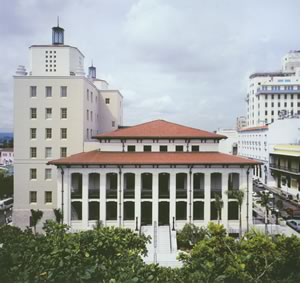 Historic
preservation, restoration, renovation
Historic
preservation, restoration, renovation
José V, Toledo U.S. Post
Office and Courthouse, Old San Juan, P.R, by Maurice N. Finegold,
FAIA, Finegold Alexander + Associates.
This exceptional restoration maintains
the maximum amount of historic fabric while integrating current security
and programmatic requirements. The project has been a catalyst for the
preservation of other historic buildings in Old San Juan. (Honor
Award)
U. S. Courthouse, Camden, N.J.,
by Daniel Kelley, AIA, MGA Partners; Catherine S. Myers, Art Conservation
Associates.
A sensitive adaptation of a historic building for modern use. The restoration
and renovation of this U.S. Courthouse is a model for recycling federal
property in city centers. (Citation)
Ariel Rios Federal Building Façade
Completion, Washington, D.C., by Enrique A. Bellini, AIA, Karn
Charuhas Chapman & Twohey.
The success of this project—to
complete an unfinished façade—is that it’s invisible.
The new design appears to be an integral part of the original 1930s construction.
(Citation)
Harry S. Truman Presidential Library
and Museum, Independence, Mo., by Dennis Strait, AIA, Gould Evans.
New elements successfully combine contemporary
architecture with the character of the original building. (Citation)
Construction excellence
Ariel Rios Federal Building Modernization—Phase
II, Washington, D.C., by Kenneth M. Grunley, Grunley Construction
Company.
A strong partnering and value engineering
process allowed for change orders while keeping the project on schedule
and under budget. (Honor Award)
James H. Quillen U.S. Courthouse,
Greeneville, Tenn., by Monte McKinney, Caddell Construction Company.
Completed early and under budget, this
courthouse shows how cost-effective construction can be. Exemplary workmanship,
user satisfaction, and neighbor-friendly design elements contribute to
its success. (Honor Award)
Wallace F. Bennett Federal Building,
Salt Lake City, by James F. Allison, Big-D Construction Corporation.
Innovative cost-saving ideas make this
complicated project a model of value engineering. The contractor did an
amazing job of pre-planning the construction to minimize disturbance to
tenants. (Citation)
Copyright 2003 The American Institute of Architects.
All rights reserved. Home Page ![]()
![]()
 |
||
| An exhibition
of the award-winning projects, Of Our Time: 2002 GSA Design Awards
will be at the National Building Museum in Washington, D.C. through
October 19, 2003.
|
||